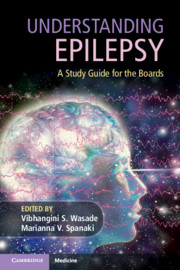Book contents
- Understanding Epilepsy
- Understanding Epilepsy
- Copyright page
- Dedication
- Contents
- Contributors
- Preface
- Chapter 1 Pathophysiology of Epilepsy
- Chapter 2 Physiologic Basis of Epileptic EEG Patterns
- Chapter 3 Pathology of the Epilepsies
- Chapter 4 Classifications of Seizures and Epilepsies
- Chapter 5 Electro-clinical Syndromes and Epilepsies in the Neonatal Period, Infancy, and Childhood
- Chapter 6 Familial Electro-clinical Syndromes and Epilepsies in Adolescence to Adulthood
- Chapter 7 Distinctive Constellations and Other Epilepsies
- Chapter 8 Seizures Not Diagnosed as Epilepsy
- Chapter 9 Nonepileptic Spells
- Chapter 10 Status Epilepticus
- Chapter 11 EEG Instrumentation and Basics
- Chapter 12 Interpreting the Normal Electroencephalogram of an Adult
- Chapter 13 Ictal and Interictal Epileptiform Electroencephalogram Patterns
- Chapter 14 Neonatal and Pediatric Electroencephalogram
- Chapter 15 Scalp Video-EEG Monitoring
- Chapter 16 Intracranial EEG Monitoring
- Chapter 17 Neuroimaging in Epilepsy
- Chapter 18 The Role of Neuropsychology in Epilepsy Surgery
- Chapter 19 Principles of Antiseizure Drug Management
- Chapter 20 Gender Issues in Epilepsy
- Chapter 21 Antiseizure Drugs
- Chapter 22 Surgical Therapies for Epilepsy
- Chapter 23 Stimulation Therapies for Epilepsy
- Chapter 24 Practical and Psychosocial Considerations in Epilepsy Management
- Chapter 25 Comorbidities with Epilepsy
- Chapter 26 System-Based Issues in Epilepsy
- Index
- References
Chapter 5 - Electro-clinical Syndromes and Epilepsies in the Neonatal Period, Infancy, and Childhood
Published online by Cambridge University Press: 11 October 2019
- Understanding Epilepsy
- Understanding Epilepsy
- Copyright page
- Dedication
- Contents
- Contributors
- Preface
- Chapter 1 Pathophysiology of Epilepsy
- Chapter 2 Physiologic Basis of Epileptic EEG Patterns
- Chapter 3 Pathology of the Epilepsies
- Chapter 4 Classifications of Seizures and Epilepsies
- Chapter 5 Electro-clinical Syndromes and Epilepsies in the Neonatal Period, Infancy, and Childhood
- Chapter 6 Familial Electro-clinical Syndromes and Epilepsies in Adolescence to Adulthood
- Chapter 7 Distinctive Constellations and Other Epilepsies
- Chapter 8 Seizures Not Diagnosed as Epilepsy
- Chapter 9 Nonepileptic Spells
- Chapter 10 Status Epilepticus
- Chapter 11 EEG Instrumentation and Basics
- Chapter 12 Interpreting the Normal Electroencephalogram of an Adult
- Chapter 13 Ictal and Interictal Epileptiform Electroencephalogram Patterns
- Chapter 14 Neonatal and Pediatric Electroencephalogram
- Chapter 15 Scalp Video-EEG Monitoring
- Chapter 16 Intracranial EEG Monitoring
- Chapter 17 Neuroimaging in Epilepsy
- Chapter 18 The Role of Neuropsychology in Epilepsy Surgery
- Chapter 19 Principles of Antiseizure Drug Management
- Chapter 20 Gender Issues in Epilepsy
- Chapter 21 Antiseizure Drugs
- Chapter 22 Surgical Therapies for Epilepsy
- Chapter 23 Stimulation Therapies for Epilepsy
- Chapter 24 Practical and Psychosocial Considerations in Epilepsy Management
- Chapter 25 Comorbidities with Epilepsy
- Chapter 26 System-Based Issues in Epilepsy
- Index
- References
Summary
Apart from age of presentation, the electro-clinical syndromes are elaborated by a distinctive and recognizable set of features including the type of seizure(s) and the electrographic traits which aggregate together.1 Imaging findings can be considered. Neurodevelopmental and psychiatric comorbidities of varying degree are often associated. Causation may be included in the classification system. According to the 2017 position paper of the ILAE Commission for Classification and Terminology, the etiology of epilepsy may be structural, genetic, infectious, metabolic, or immune. Causation may also be unknown (formerly cryptogenic).2 Idiopathic and self-limited (formerly benign) epilepsies occur in children with a normal neurological examination and normal neuro-imaging, in whom there may be a familial predisposition. The term idiopathic (as opposed to genetic) is still preferred by some in respect of four well-recognized idiopathic generalized epilepsy syndromes (IGEs): childhood absence epilepsy (CAE), juvenile absence epilepsy (JAE), juvenile myoclonic epilepsy (JME), and generalized tonic–clonic seizures alone (formerly generalized tonic–clonic seizures on awakening). Although monogenic or more complex genetic or environmental susceptibility factors may be implicated in these epilepsies, the mechanisms are not always fully elucidated. The attribution to genetic causation may incorrectly suggest a high rate of inheritance. Benign focal epilepsies, such as benign or childhood epilepsy with centrotemporal spikes (CECTS) and the occipital lobe epilepsies of Panayiotopoulos and Gastaut are, again according to the position paper, termed self-limited as the term benign does not seem to fully address the developmental impact of these transient epilepsies.2 The epileptic encephalopathies, recognized as a distinct category, comprise a polymorphous group of epilepsy syndromes in which the epileptic activity itself contributes to cognitive and behavioral impairments above and beyond what might be expected from the underlying pathology alone.1 There is abundant epileptiform activity and inherently there is the idea that limiting or suppressing the activity will improve the neurodevelopmental outlook.
- Type
- Chapter
- Information
- Understanding EpilepsyA Study Guide for the Boards, pp. 77 - 109Publisher: Cambridge University PressPrint publication year: 2019



